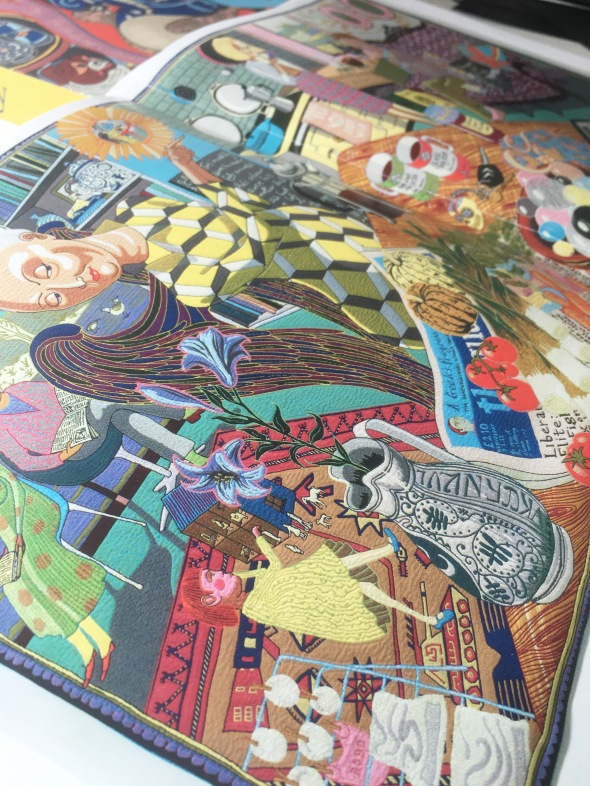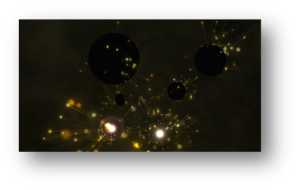Alzheimer’s petients interview
Posted: May 1, 2016 Filed under: Level 6 Subject, Subject | Tags: Alzheimer's, CSAD16, embroidery, illustration, stitch Leave a commentMy second involvement with LAUGH project by Prof Cathy Treadaway from CARIAD Cardiff is to document a conversation between her team and members of SURPS group & Alzheimer’s society based in Cardiff. The session outcome was very valuable and gave a lot of insight to daily life and how patients really feel about the disease and how they cope with it.
Here’re sketches from the session:
Inspired by Greyson perry’s The Annunciation of the Virgin Deal and David Hockney’s photo collage composition, I’ve made design as one of the final outcome of my project. The work is hand embroidery on different sizes of hoops, put together to look like a collage and texts to highlight the conversation. I chose the colour to be bright because I think it is important to lift the mood and as a reflection of the patients’ life.
Bellow is the 1st finished version illustration shown for Within/Without group exhibition at PaperArts, Bristol. I have made the text into 3D texts using thread to give more impact to the work for Summer show.
Further more, I have prepare stitch text which I’m going to display for the degree show.
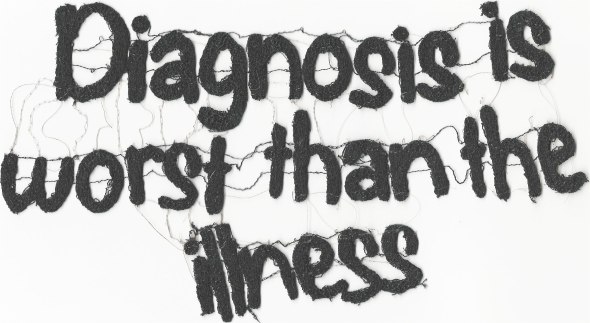
text 1 – © Ayu Baker 2016
Visual song activity
Posted: May 1, 2016 Filed under: Field, Level 6 Encounter, Level 6 Subject, Subject | Tags: Alzheimer's, cardiff, CSAD16, embroidery, illustration, stitch 2 CommentsI always remember the fun memory I had with my late father and my sisters on weekend where we would play records and sing along to it. He loved Engelbert Humperdinck’s songs. He had all of his records and used to perform his songs on stage every year at independence day celebration. Several years after he had been diagnosed with Alzheimer’s, he began to forget the lyrics of his fav songs. We used to belt out the ref to Please release me and Quando, Quando, Quando. Although he can’t remember the lyrics no more he was still able to recognise the rhythm of those songs and then played them on repeat.
That memory inspired me to come up with an activity that aims to encourage conversation between Azlheimer’s patients with their carers through listening to music and embroidery. Research shown that music can boost our brain activity that is linked to memory, cognition and problem solving. The embroidery work will take form as an abstract art that is generated from music visualisation apps.
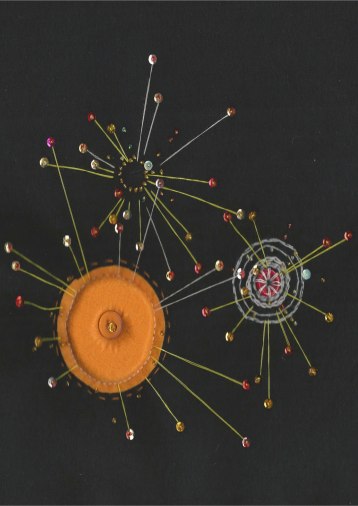
Quando, Quando, Quando, E. Humperdinck – song visualisation © Ayu Baker, 2016. Thread & Textile.
How it work:
- the activity will involve stitching which kit I will provide at the exhibition. The kit includes embroidery hoop and fabric, thread and needle, and instruction sheet.
- Before starting the embroidery work, carer would have to download music visualisation app into their smartphones, laptop or tablet from online app store. The apps that are free to download are iTunes, Audiogasm, Gravitarium or Svarm and Wizzj.
- Once the apps is downloaded, carer can play patients’ fav song on it and then take a screenshot of the abstract art. Sample:
- Carers then can start the embroidery work while listening to the song with the patients and have conversation down the memory lane. Sample is on the 1st above image.
So for the exhibition I have prepare 20 embroidery kits that I will give out to people who are interested and is a carer to Alzheimer’s patients, and if I still have spare I would introduce and give them to nursing home or Azheimer’s Society Cardiff.
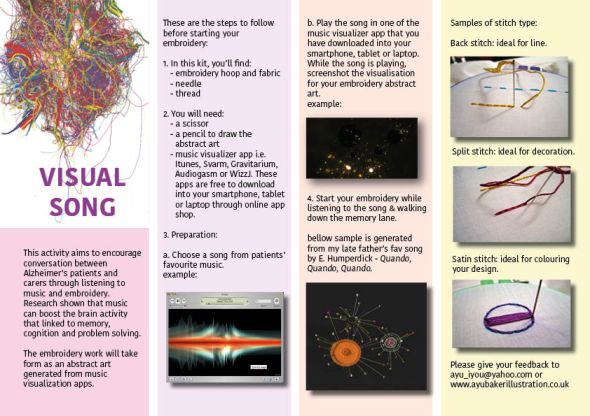
embroidery kit instruction © Ayu Baker 2016.
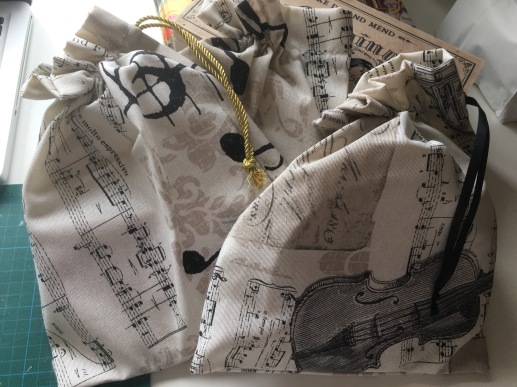
a few of the embroidery kits
Greyson Perry – The Vanity of Small Differences trip
Posted: May 1, 2016 Filed under: Level 6 Subject, Subject | Tags: bath, greyson perry, illustration, trip Leave a commentWe went to Bath to see Grayson Perry’s latest tapestry work exhibited at Bath Museum. It was an inspiring exhibition and Bath city was very nice and clean. Perry had based the work from his research & documentary TV series on Channel 4 called All in the Best Possible taste with Greyson Perry in 2012. Perry’s tapestry large size works, composition that allures me to look for insight of background story and vibrant colours really help brings out the illustration and story line.
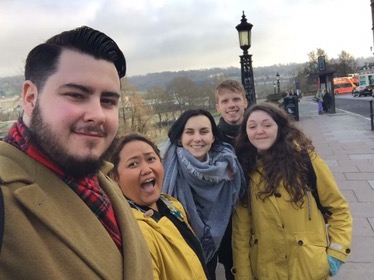
The gang!
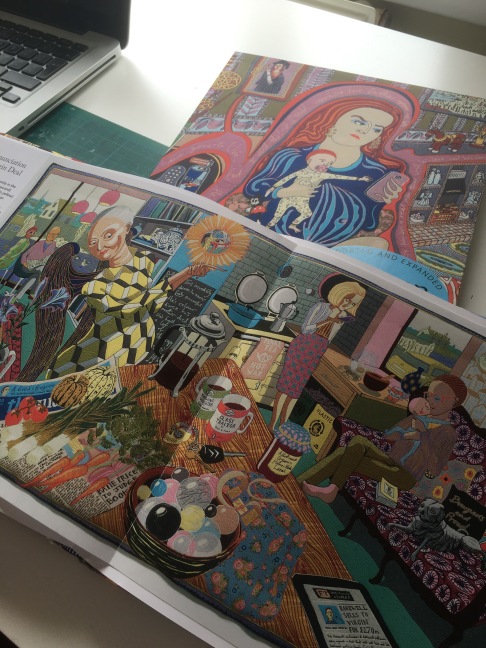
goodies brought back from the trip. Greyson Perry’s books.
Fundraising for show’s promotional catalogue
Posted: May 1, 2016 Filed under: Field, Level 6 Encounter | Tags: bake sale, CSAD16, fundraising, illustration Leave a commentI joined as one of illustration committee for my year catalogue and as one of our effort to fund it is by raising money through bake sale. I always enjoy the prep and logistic side of organising so this time I helped out with some table cloth, plates, and decorations. I participated twice in the bake sale and It was a lot of fun to bake this year as I’m passionate in raising the money so that we can get the catalogue that we all wanted. It was also a good decision to bake savoury food instead of the sweet because a lot of students prefer savoury and a change from the sweets. Although we didn’t raise full amount of money but we managed to raise almost half of the required full fund which is £2000.
We also had a Davie Bowie night to raise some money as well, and sadly I couldn’t participate because I have other engagement to attend, although I donated drinks and snack towards it.

Illustration Bake sale 2016
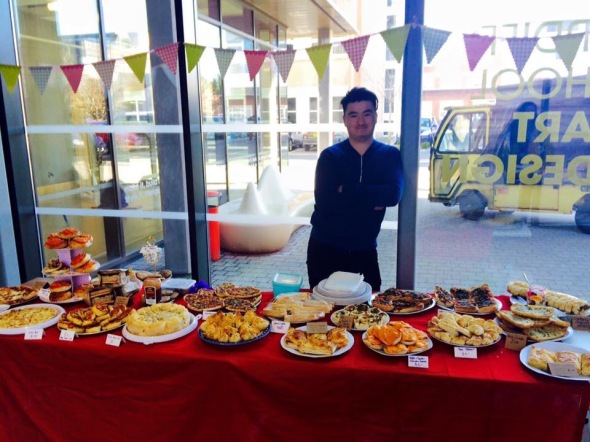
Illustration bake sale 2016. Thanks to Patrick H for manning the stall.
Diss Reflection
Posted: January 27, 2016 Filed under: Constellation, Level 6 Dissertation, Uncategorized Comments Off on Diss ReflectionMy dissertation year was stressful but insightful. I’ve learn so much from the subject matter which is metaphor, because it links to my illustration. I’ve always been interested in the use of metaphor in visual art. Surrealists such as Rene Magritte, Frida Kahlo and Salvador Dali always captured my attention with their use of symbols and metaphor. I’ve also always been interested in social and political change throughout the year that were influenced by art, such as contemporary, modern and pop designs & art movements, fashion style and 60’s and 70’s lifestyles but as well as metaphor that were use to change the religious symbols meanings and our culture.
Soon as my proposal is agreed between my tutor and I, I began my research by reading books edited by Andrew Ortony (n.d.) Metaphor and thought, in which a collection of papers by theorists of metaphor use in communication, learning and everyday live. From this book I gathered more reference about conceptual metaphor introduced by non constructivist such as George Lakoff (1941) and Mark Johnson (1949), Max Black (1909 – 1988), Christopher Tilley (n.d.) and many others. My tutor advised me to read upon a book about symbols by Carl Jung. His book, Man and his symbols has influenced me greatly, especially with my understanding about symbols history, meanings, perceptions, myth, dreams and the unconscious/unconscious mind. From here I began to see in depth connection between symbols and metaphor, which is that one is supporting the other for use in self expression, communication and influencing change in society or individual.
I think that our library book and online collections are extensive. I have received great service from the staffs when I need it most, in particularly when I need to borrow books or online journals from other library sources. I do not have a very good writing skills, however my tutor advised me to start by making statements of research outcome into bullet points so that it would help me in constructing paragraph and chapters. I’ve also made a diagrams to make it easier for me to plan the structure of my writing. The diagrams includes plans for each chapters, quotes, theories, examples, arguments, questions and summery of my research and possible conclusion. The diagrams had helped me to keep focus on my intentions and to keep check on what I may have missed or need to investigate more.
Conceptual metaphor involves thought process. There are two domains in the metaphor where one source domain (familiar idea/concepts) is use to help explain the target domain (unfamiliar idea/concepts). The viewers is invited to find connection and comparison between two domains, thus have a new understanding about the unfamiliar idea/concepts. Our mind stored vivid images of events, memories, objects, feelings that have personal attachments, thus symbols. Each person have their own perception of symbols, in which created naturally or by culture. Lakoff & Johnson are the first to introduce a theory that when a new conceptual metaphor is introduce to an old system, it can change a person or society way of lives, however it can only happen when the old system is loss. Artist have the power to introduce new ideas/concepts through conceptual metaphor and symbols. This power can be taken advantage by certain group to gain control over the other, i.e. political, social or religious purposes. However it can also bring positive things to a person and society, therefore it can build the self and empower them. As an illustrator, I believe that this theory could bring innovative, talkative and creative way to convey my intentions through my art, therefore evoke a reaction or response from the viewers.
Artist such as Frida Kahlo whose self portrait and still life works are full of symbols and metaphor had influenced my work. In her work Self-portrait with thorn necklace and hummingbird (1940) and Moses: nucleus of creation (1945) she infused her Mexican heritage, aztec culture, her Christian belief and life stories into her work. She successfully built a relationship between her self, the work and the viewer in her self expression in conveying her feelings, emotions, suffering and aspirations & dreams. Even though she was bed ridden in majority of her life, she managed to use her mind, body and environment to create her art. She also inspired others through her Moses: nucleus of creation by taking stand on her womanhood, placing woman forward in front of male, woman as the creator of life, hence referenced to Mexican Virgin of Guadalupe symbol.
Other artists that have also inspired a generation is Jackson Pollock, in particular is his 1952 work Convergence. The paint splash & drip method, vibrant colour, texture and abstract shapes is considered to be innovative at the time where the US was looking for a change in economic condition and culture. He was a pioneer in freedom of expression and creativity in compare with the conventional european art style. Pollock has a big influence in American abstract expressionist movement. This however have been taken advantage by the CIA and used as a propaganda tool in the cold war against communist Soviet Union. New art such as jazz music was also being ‘supported’ by the CIA in order to create new America.
I hope that I did my dissertation justice. All the tutorials sessions I had was very helpful in terms of starting off my research and focus on finding the question and structure of my dissertation. My tutor was very open with consulting about other stuffs as well, so that it did not interfere with my concentration in writing. What I could take from writing dissertation is that personally, I think my academic writing skill has improved. I learnt so much from my subject matter in which also feed into my subject module. Taking from this research and writing experience, I hope that I have found a balance in creating my illustration between my skill of technical or art approach, social realism but also freedom of expression & creativity, therefore convey and communicate my intentions to inspire myself and maybe others.
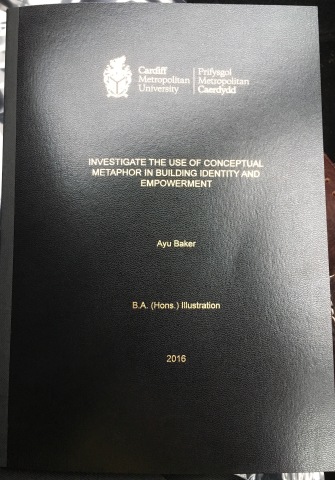
Alzheimer’s: Beyond the Gene? seminar
Posted: November 24, 2015 Filed under: Level 6 Subject, Subject | Tags: Alzheimer's, seminar Leave a commentYesterday I attended Alzheimer’s: Beyond the Gene? seminar held by Carduff University & Bristol University. Speakers at the seminar presented the latest neurogenetics research in connection with finding drugs and ways to cure Alzheimer’s disease, Parkinson’s, and dementia.
Talks that I found interesting were from Proff John Hardy on his research findings in identifying DNA that can repair neurons in cerebellum (part of brain that helps control movements, language and attention) that caused progressive Alzheimer’s and dementia, and a talk from Dr David Llewellyn findings based upon the English Longitudinal Study of Ageing (ELSA) and Algorithmic approaches to Dementia Identification.
Dr Llewellyn and his team is developing an app called DECODE Dementia that can help detect dementia. He based his research on >12k participants aged 50+ from 2002 on their health, cultural background, wellbeing, financial, nurse visit & physical function data into algorithm for more accurate & clinical identification.
These researches are still continuing in the hope of findings the right drugs to cure and eliminate alzheimer’s and dementia. I wish to include these promising research in my illustration book about Alzheimer’s.
Sketching for CARIAD – dementia project
Posted: November 24, 2015 Filed under: Level 6 Subject, Subject | Tags: late-stage dementia, nursing home, sketches Leave a commentI’m not a reportage kind of illustrator hence my “not-up to standard sketches” bellow, however I had the opportunity to observe and draw a presentation of Sensory-project gifts from CARIAD last Sunday (23rd Nov, 2015). CARIAD has been working with Gwalia Mydwydd Mawr nursing home in Carmarthen since earlier this year to provide patients with dementia with sensory aprons and HAND pockets in which function is to evoke their memories and senses. The aprons and pockets are individually customised based upon each patients’ life story. They are made of textile with a technology attached that can play sounds or songs.
When patients were presented with the gifts, their memories were recalled from the customised items attached to the aprons, i.e. soft violins, soft dolls, tassels, flags, sounds, and evoked their senses from touching the texture or pattern of the textile. One patient started to sing once a bird chirping sound played, another patient started to tell stories of her traveling experience in Russia once she saw the flag, another patient was playing her soft doll because it reminds her of her children.
In my opinion this event has proof that recalling memories and senses through physical objects, conversation and play are important because it shows the essence of the person with dementia is still intact, hence their personality came back even though only for a little moment. It also a great way to reconnect with families through conversation and play.
Based upon this experience, I’d like to create a 2D-3D embroidery that can bring back that moment to highlight the importance of spending time with love ones and documenting the shared past or present moments and memories.
Summary of Alzheimer’s Disease – Dementia project
Posted: November 15, 2015 Filed under: Level 6 Subject, Subject Leave a commentDementia is an umbrella term for Neurologic/Psychiatric diseases that is caused by two protein that formed plaques on neurons in which make them not be able to connect with each other to perform a task. Such tasks perform by synapses between neurons for example are to store memories and to re-collect memories, simple everyday chores, reading, making plans, regulating mood, and etc. The disease attacks the motor system it causes Parkinson’s, when it attacks the mood system it causes depression, or when it attacks memory part of the brain it causes Alzheimer’s, and so on. Based upon research, it is predicted that in 2050 there will be more people suffer from dementia and the chance is 1 in 2 people either have dementia or care for someone who have dementia. There is no cure for dementia yet.
First, the disease attack the part of brain that stores & regulates memories – Hippocampus then it spread all over the brain. At the end, the disease will destroy part of brain that regulate senses, breathing and heart. Each person diagnosed with dementia have different symptoms in which make it difficult for researchers to find a cure.
It is also a personal reason for me to choose Alzheimer’s as my subject matter because my father was diagnosed with Alzheimer’s at the age of 50 and died of because of heart disease.
My intentions is to change old perception that dementia is age-related illness, and for everyone to be able to recognise early-onset dementia symptoms quickly, because unlike cancer or AIDS which illness can be seen physically fairly quickly, early-onset dementia can not be seen physically. Its symptoms can only be seen through changes of behaviour that we need to observe through time because the disease attacks our memory stored in the brain, effects the way we feel/mood and changes personality. As soon as we received proper diagnosis, the better we understand what type of dementia we have and make our plans for the present and future.
But most importantly is that by understanding symptoms of early-onset alzheimer’s we can provide more friendly environment for people with alzheimer’s/dementia. For example, If we meet a person with dementia doing their everyday chores but suddenly they forget what they meant to do or where they are going, we can patiently assist them so they can remember what they intended to do or where they wanted to go. We need to create the friendly environment everywhere, in schools, in the shops, at the office, community leisure centres, and so on. This is not only applies for assisting dementia patients to get through the day but will also support their family and carers.
So, my first idea is to create a room where everyone can experience what is like to live with early-onset of dementia. The aim is to change old perceptions that alzheimer’s/dementia is an age-related illness. The disease could attack every person as young as in their late 40’s and no matter what life-style they’ve had (healthy, active, academic, etc.) Early-onset dementia symptoms is when we loss ability in speech/language, reading, coordination, calculating, planning and short term memory lost. Things planned to be included in the participation:
- To include continuing buzzing sound/noise (with headphone) that could influence the thought process (perceived from experiences) of normal people. When our thinking process to do activities is disturb, out concentration/focus is effected and we would not be able to do simple chores, for example putting the right pair of socks on or putting shirts back into drawer, and so on.
- To invite public do simple everyday chores when they enter the installation.
- To get feedback from the experience
- The objects may/will be made out of thread and textile.
Second idea is to display/create installation of fragmented objects & memories. I choose everyday objects and memories because we perceived our own perception of objects and memories through bodily experiences. The aim of fragmented everyday objects/memories is to represent loosing coordination, having hallucinations and loosing feeling/sensitivity-empathy, changing of personality and short-term memory loss suffered by early-onset dementia patients. Although, I believe that the essence of the person is still inside, it needs to be brought back by sparking their memories and senses. So fragmented objects can also represent the memory/senses coming back as well as represent disappearance.
Process of creating the objects/image: will be made with thread (embroidery) & textile and stitch on dissolvable fabric. Then the fabric will disappear once it’s put in warm water leaving the stitched image still intact. The process where the fabric disappear represents the loss of memories, however the stitched image left represents the essence that is still inside of the person who have alzheimer’s, i.e. love, interest, etc.
Third idea is to make a book that consists of scientific information about alzheimer’s disease, symptoms, recent research. The book is aimed for general public to understand about alzheimer’s and persuade them to support research in finding the cure for alzheimer’s/dementia and to get involve through joining a training session (Dementia Friends) to create a more friendly environment for people with alzheimer’s-dementia.
In addition, I hope Alzheimer’s seminar I’m going to attend at Bristol Uni on Nov. 23rd and my involvement with CARIAD dementia project will bring more insights into my ideas for this project.
Alzheimer’s seminar & CARIAD project involvement to support my intentions
Posted: November 15, 2015 Filed under: Level 6 Subject, Others, Seminar/Talk/Symposium, Subject | Tags: dementia, stitch Leave a commentWith the help of Louisa, I’ve got in contact with a neuroscientist from Bristol University. He referred me to a seminar to present recent development in alzheimer’s disease research. I’ve booked a space to attend the seminar Alzheimer’s: Beyond the Gene scheduled on Nov 23rd in hope that I gain more knowledge and understanding about finding a cure to alzheimer’s. The seminar is a join seminar from Cardiff University and Bristol University. See attached file for detail programme.
I’ve attended a lecture by Prof. Cathy Treadaway on Oct 14th on her research and design project with CARIAD – Centre for Applied Research in Inclusive Arts and Design titled Making a Difference: Designing for Happiness. The lecture was about her involvement in helping people on late stage of dementia through sensory object – HANDS design to spark memory loss.
Using practical participatory approaches, in which people are kept at the heart of the process, it is possible to gain insights into human experience and then design positively to promote human flourishing and enhance wellbeing.
Creative activities can be used as powerful and life-changing opportunities to contribute to dialogues in the design process. Making by hand, gesture and touch can be used as valuable tools to unlock thinking, reframe problems and aid communication. Participatory approaches that combine empathy and creative group activities are being used in a number of CARIAD led international research projects that seek to address the global design challenge of caring for our ageing society. LAUGH, Sensor e-Textiles, Hand i Pockets and HANDS are all projects that focus on design to support the wellbeing of people with dementia.
The lecture has inspired me, so I sent an email to Prof Treadaway to request for a chance to get involve in her project. After a meeting with her few weeks back, she is giving me the opportunity to observe and draw a Tea party at a nursing home in West Swansea on 22nd of November for a celebration of handing over memory aprons to dementia patients. Hopefully what I gain from the event would be able to feed to my current project as well as producing a response that communicate a message & raising awareness of dementia.
Ideas: 3 – Information book about alzheimer’s
Posted: November 15, 2015 Filed under: Level 6 Subject, Subject | Tags: book draft, dementia Leave a commentThe book will consists of scientific information about alzheimer’s disease, symptoms, recent research. The book is aimed for general public to understand about alzheimer’s and persuade them to support research in finding the cure for alzheimer’s/dementia and to get involve through joining a training session (Dementia Friends) to create a more friendly environment for people with alzheimer’s-dementia.






